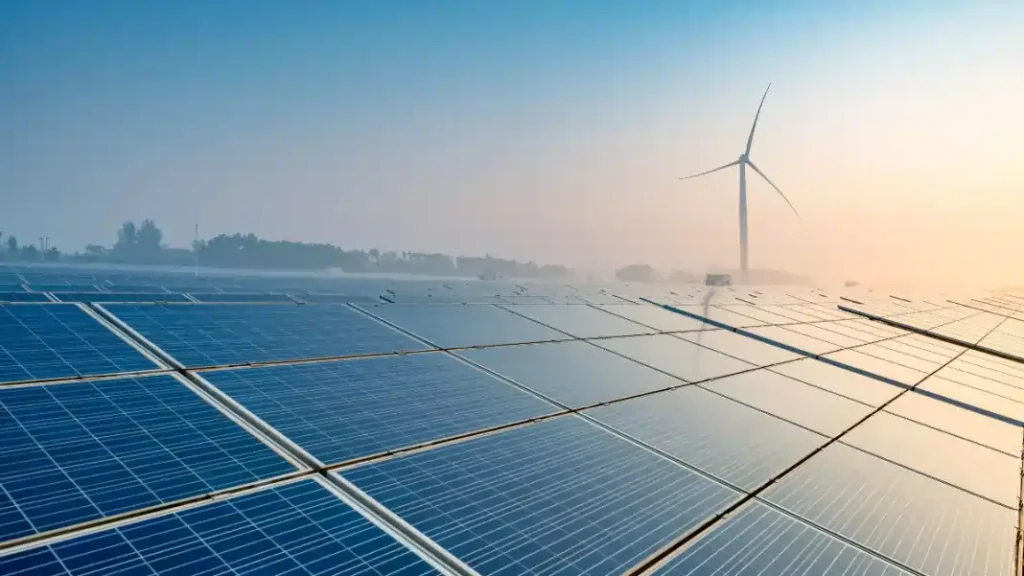New Delhi : India achieves 50% non-fossil fuel power capacity five years early, showcasing global climate leadership
In a historic milestone, India has reached 50% of its installed electricity capacity from non-fossil fuel sources, achieving this target five years ahead of its 2030 goal under the Nationally Determined Contributions (NDCs) to the Paris Agreement. As of June 30, 2025, the Ministry of New and Renewable Energy reports that India’s total installed power capacity stands at 484.82 GW, with 242.78 GW (50.08%) derived from non-fossil fuel sources, including renewable energy (RE), large hydro, and nuclear power. This achievement, announced on July 14, 2025, by the Press Information Bureau (PIB) Delhi, positions India as a global leader in clean energy transition, demonstrating that economic growth and environmental stewardship can coexist harmoniously.

A Landmark in India’s Energy Transition
Union Minister of New and Renewable Energy, Shri Pralhad Joshi, celebrated this achievement, stating, “In a world seeking climate solutions, India is showing the way. Achieving 50% non-fossil fuel capacity five years ahead of the 2030 target is a proud moment for every Indian. Prime Minister Shri Narendra Modi’s leadership continues to drive Bharat’s green transformation — paving the path towards a self-reliant and sustainable future.” This milestone underscores India’s commitment to climate action, sustainable development, and energy sovereignty, setting a global benchmark for developing nations.
India’s clean energy journey has been propelled by visionary policies, robust implementation, and a commitment to climate equity. The country’s total installed capacity of 484.82 GW comprises 242.04 GW (49.92%) from thermal sources, 8.78 GW (1.81%) from nuclear, 49.38 GW (10.19%) from large hydro, and 184.62 GW (38.08%) from renewable energy sources such as solar, wind, and bioenergy. The non-fossil fuel share, combining renewable energy, large hydro, and nuclear, totals 242.78 GW, achieving the 50.08% mark.
Key Initiatives Driving India’s Renewable Energy Surge
Several flagship programs and policies have fueled India’s rapid progress in renewable energy adoption:
- PM Surya Ghar: Muft Bijli Yojana
Launched in 2024, the PM Surya Ghar scheme has revolutionized rooftop solar adoption, facilitating approximately 7 lakh installations across one crore households. This initiative promotes decentralized energy generation, empowering citizens to become “prosumers” — both producers and consumers of energy. By making solar energy accessible to households, the scheme has democratized clean energy and reduced reliance on centralized grids. - PM-KUSUM (Pradhan Mantri Kisan Urja Suraksha evam Utthaan Mahabhiyan)
The PM-KUSUM scheme has transformed rural energy landscapes by providing solar-powered pumps to lakhs of farmers, ensuring energy-secure and sustainable agriculture. The program also supports agrovoltaics and feeder-level solarization, enhancing rural livelihoods and energy access. Following its success in states like Rajasthan, Gujarat, and Madhya Pradesh, Union Minister Joshi announced the upcoming launch of PM-KUSUM Yojana 2, driven by demand from 20 state ministers and growing investor interest in solar and wind sectors. - Manufacturing Expansion through Production Linked Incentive (PLI) Schemes
India has scaled up domestic production of solar photovoltaic (PV) panels and wind turbines through PLI schemes, reducing dependence on imports and fostering energy sovereignty. This initiative has bolstered industrial growth and created significant employment opportunities across the renewable energy value chain. - Transmission Infrastructure Enhancements
Major investments in inter-state transmission systems have enabled efficient evacuation of power from renewable-rich states like Gujarat and Tamil Nadu. These upgrades ensure that clean energy reaches consumers across the country, supporting grid reliability and scalability. - Green Energy Open Access Rules 2022
These rules have promoted renewable energy access for consumers, encouraging businesses and households to adopt clean energy solutions. By simplifying access to green energy, the policy has accelerated the transition to a sustainable energy ecosystem. - Foreign Direct Investment (FDI) Policy
India’s renewable energy sector allows 100% FDI under the automatic route, attracting record capital inflows. This policy has spurred innovation and investment in solar, wind, and battery storage technologies. - Viability Gap Funding (VGF) for Offshore Wind
The VGF scheme supports the implementation of offshore wind energy projects, expanding India’s renewable energy portfolio and harnessing untapped potential in coastal regions.
Co-Benefits of India’s Clean Energy Revolution
India’s renewable energy expansion has delivered far-reaching co-benefits beyond decarbonization:
- Reduced Import Dependence: By prioritizing domestic renewable energy production, India has enhanced its energy sovereignty, reducing vulnerability to global fuel price volatility.
- Diversified Energy Portfolio: The integration of solar, wind, bioenergy, hydro, and nuclear power has created a resilient and balanced energy mix, capable of meeting diverse energy demands.
- Job Creation and Industrial Growth: The renewable energy sector has generated massive employment opportunities, particularly in rural areas, through initiatives like bioenergy and solar park development.
- Improved Public Health and Air Quality: By reducing reliance on coal-fired power, India has decreased air pollution, leading to better public health outcomes.
- Enhanced Rural Incomes: Programs like PM-KUSUM have empowered farmers with solar-powered irrigation, boosting agricultural productivity and economic stability.
India’s Global Climate Leadership
Despite having one of the lowest per capita emissions globally, India is among the few G20 nations on track to meet or exceed its NDC commitments. At international forums like the G20 and the Conference of Parties (COP) to the United Nations Framework Convention on Climate Change, India has consistently advocated for climate equity, sustainable lifestyles, and low-carbon development pathways. Achieving the 50% non-fossil fuel milestone ahead of schedule reinforces India’s position as a clean energy frontrunner, proving that developing nations can lead the global clean energy transition without compromising economic growth.
In 2024, India produced 2,030 terawatt-hours (TWh) of electricity, with 240.5 TWh drawn from renewable sources, according to the Energy Institute’s Statistical Review of World Energy. The country added nearly 28 GW of solar and wind capacity in 2024, with an additional 16.3 GW added in the first five months of 2025. Excluding large hydro, renewable energy accounted for 184.6 GW of installed capacity by June 2025, highlighting the rapid pace of India’s clean energy growth.
The Road Ahead: Ambitious Targets and Technological Innovation
India’s early achievement of the 50% non-fossil fuel target sets the stage for even bolder ambitions. The country aims to reach 500 GW of non-fossil fuel capacity by 2030 and achieve net-zero emissions by 2070. To realize these goals, India is focusing on several key areas:
- Doubling Per Capita Clean Electricity Consumption
Emphasis on distributed renewable systems and energy-efficient appliances will increase clean energy access, particularly in rural and underserved regions. - Building a Robust, Digitally Integrated Grid
A modernized electricity grid capable of managing high renewable energy penetration, demand fluctuations, and two-way power flows is essential. AI and digitization will play a pivotal role in demand forecasting, predictive maintenance, and automated grid management. - Expanding Energy Storage
Battery Energy Storage Systems (BESS) and pumped hydro storage will ensure grid reliability and round-the-clock power availability, addressing the intermittency of renewable sources. - Promoting Circularity
Sustainable lifecycle management of solar panels, wind turbine blades, and batteries will minimize environmental impact and support responsible resource use. - Green Hydrogen as a Future Fuel
Accelerated investments in green hydrogen will drive decarbonization across industrial sectors, positioning India as a leader in next-generation clean energy technologies.
AI and Digitization: The Future of India’s Energy Infrastructure
Artificial Intelligence (AI) is poised to revolutionize India’s energy sector. AI-driven platforms will enable intelligent energy marketplaces, integrating rooftop solar, electric vehicles, and smart meters. These systems will empower consumers to actively participate in energy production and consumption. However, increased digitization necessitates robust cybersecurity measures to protect critical infrastructure from cyber threats, data breaches, and algorithmic manipulation.
Private Investment and Policy Support
Speaking at the IVCA Renewable Energy Summit 2025 at IIT Bombay, Union Minister Joshi emphasized the critical role of private investment in achieving India’s 500 GW non-fossil fuel target by 2030. The renewable energy sector is witnessing unprecedented momentum, with strong policy support and record capital inflows into solar, wind, battery storage, and green manufacturing. The upcoming PM-KUSUM Yojana 2 will further accelerate renewable energy adoption, building on the success of its predecessor.
A Global Benchmark for Sustainable Development
India’s achievement of 50% non-fossil fuel capacity ahead of schedule is a testament to its ambition, innovation, and commitment to sustainable development. As Shri Pralhad Joshi stated, “India’s clean energy transformation is not just an environmental objective; it is a national mission.” By balancing development and decarbonization, India is lighting the path for a greener, cleaner, and more inclusive future.
As the nation moves toward its 2030 and 2070 goals, the focus remains on bold, inclusive, and technology-driven strategies. India has already lit the lamp of clean energy progress; now, it is time to let it shine brighter—for the nation and the world.
Frequently Asked Questions (FAQs)
1. What does India’s achievement of 50% non-fossil fuel capacity mean?
India has reached a milestone where 50.08% of its total installed electricity capacity (242.78 GW out of 484.82 GW) comes from non-fossil fuel sources, including renewable energy (184.62 GW), large hydro (49.38 GW), and nuclear (8.78 GW). Achieved on June 30, 2025, this milestone was met five years ahead of the 2030 target set under the Paris Agreement, showcasing India’s leadership in clean energy transition.
2.What initiatives drove India’s rapid progress in renewable energy?
Key programs include the PM Surya Ghar scheme, enabling 7 lakh rooftop solar installations; PM-KUSUM, providing solar-powered pumps to farmers; Production Linked Incentive (PLI) schemes for domestic solar and wind manufacturing; enhanced transmission infrastructure; Green Energy Open Access Rules 2022; 100% FDI in renewables; and Viability Gap Funding for offshore wind projects.
3.What are the benefits of India’s clean energy transition?
This transition reduces reliance on imported fuels, enhances energy sovereignty, diversifies the energy mix, creates jobs, and boosts rural incomes through schemes like PM-KUSUM. It also improves public health by reducing air pollution and supports inclusive growth, aligning economic development with environmental sustainability.
4.How does India’s achievement impact its global climate standing?
Despite low per capita emissions, India is among the few G20 nations exceeding its Nationally Determined Contributions (NDCs). This milestone, achieved ahead of schedule, reinforces India’s advocacy for climate equity and sustainable development at global forums like the G20 and COP, setting a benchmark for developing nations.
5.What are India’s future clean energy goals and strategies?
India aims for 500 GW of non-fossil fuel capacity by 2030 and net-zero emissions by 2070. Strategies include doubling per capita clean energy consumption, building AI-driven smart grids, expanding battery and pumped hydro storage, promoting green hydrogen, and ensuring cybersecurity for digital energy infrastructure.

